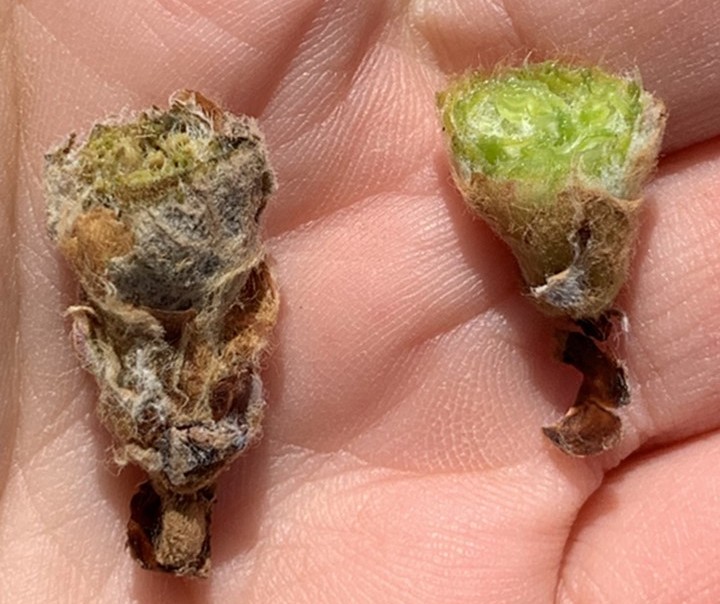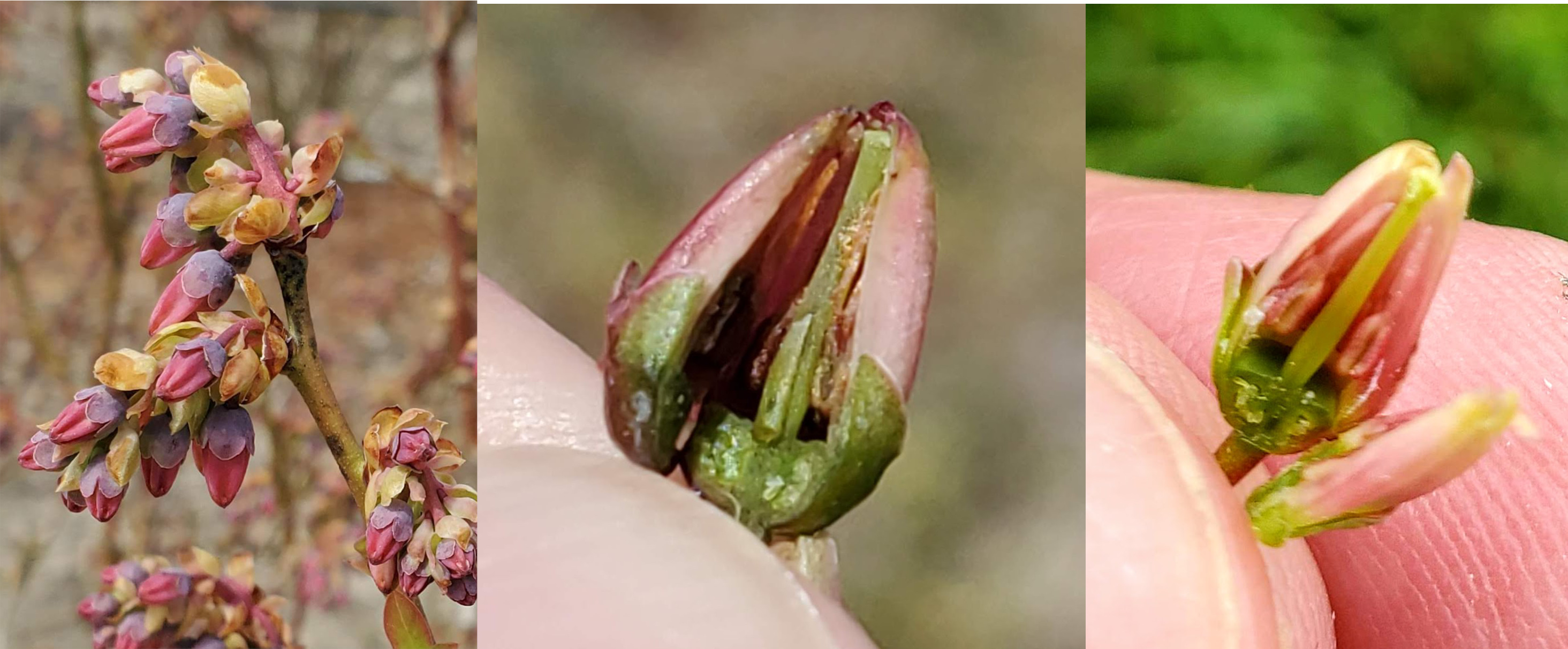Southwest Michigan fruit update – May 12, 2020
A freeze Saturday, May 9, caused damage to most fruit crops in the region. Growers will assess damage this week and determine how to adjust their management.

Weather
Last week was cold and dry. High temperatures were in the upper 50s. Lows were in the 40s and 30s. Friday, May 8, was cold and very windy with the arrival of a cold polar air mass. The winds died overnight and the region suffered a widespread freeze with low temperatures into the mid- and low 20s, which damaged fruit crops. A storm front crossed the region Sunday, bringing reports of light to moderate amounts of hail and dropped about a third of an inch of rain. Soils continue to dry out.
Light frosts forecast for the next few days should not cause any additional damage. Temperatures should rise mid-week with highs in the 70s and lows in the 50s. The increased temperatures will bring precipitation and a chance of thunderstorms: good conditions for disease development in many fruit crops.
With the cold week, we picked up few growing degree days (GDD) last week: 32 GDD base 42 and 7 GDD base 50.
|
Southwest Michigan GDD summary from March 1 – May 10, 2020 | |||
|---|---|---|---|
|
Station |
GDD 42 F |
GDD 45 F |
GDD 50 F |
|
Benton Harbor (SWMRC) |
303 |
214 |
109 |
|
Lawton (Lawton) |
318 |
226 |
116 |
|
Fennville (TNRC) |
252 |
169 |
74 |
|
Average for the SW region |
308 |
218 |
112 |
|
Average last week |
276 |
199 |
105 |
Frost/freeze information
The freeze Saturday morning, May 9, 2020, dropped temperatures into the mid- to lower 20s. Cold, strong winds blew all day Friday and died down overnight. There were few clouds to hold in heat. Temperatures in the low 20s would damage most fruit crops in the region. The coldest temperatures were in the region east of Benton Harbor and west of Kalamazoo (20 to 26 degrees Fahrenheit). There were warmer temperatures both to the north and south. Southern Berrien County (30 to 27 F) and northern Allegan county were both warmer than the I-94 corridor. Areas close to Lake Michigan were warmer than interior sites.
There was a weak inversion. There seemed to be a two-degree difference between high and low sites in the region. Some growers used wind machines and irrigation to prevent damage to their crops. Growers will be assessing the level of damage for most of the week. We expect light to severe damage depending on the crop and site.
Tree fruit
Apple, pear and cherry development has been very slow over the past two weeks. Oriental fruit moth and redbanded leafroller flights have begun. There is still time to set up mating disruption for oriental fruit moth in peaches and apples.
Apricots are in the shuck. Apricots were hurt by April freezes and again by the low temperatures of late last week.
Peaches and nectarines range from bloom to petal fall. Flower density is high this year, which should help to offset freeze damage from the past weekend. There is a range of damage in the area due to temperature and varieties.
Dieback of branch tips is conspicuous due to damage last year by bacterial spot, phomopsis infections and entries by oriental fruit larvae. Low levels of copper from early spring to early shuck split are useful in suppressing bacterial spot populations. The amount of copper is to be reduced as the season progresses and growers need to monitor for phytotoxicity. Peach leaf curl symptoms have appeared in central Berrien County and can be traced back to an infection period on March 27.
Oriental fruit moth flight began last week. This correlates with the estimated biofix (first trap catch) at 175 GDD base 45. Timing of peach scab control is approaching. Management of this disease focuses on protecting fruit starting at shuck split.

Sweet cherries are at petal fall to in the shuck. Freeze damage is significant with less damage in good sites. We will have a better handle on the crop as the fruit emerges from the shuck. Montmorency tart cherry are still in bloom. Freeze injury is widespread but very variable from moderate to severe. Brown rot management is important when warm temperatures and rain occur together during bloom. Cherry leafspot management should begin in the latter half of bloom for tart cherries. This will protect the tiny bract leaves, the first to unfold and become susceptible to infection.
Japanese plums are in the shuck and European types are in petal fall. The weekend freeze was hard on plums. Growers need to prune out black knot and dispose of the knots by burning or removing infected wood from the orchard. Sanitation is very important in managing this disease.
Apple buds are at pink to king bloom open. Varieties most affected by the weekend freeze appear to be Gala, Fuji and Jonagold. Growers need to maintain their sprays to control apple scab. Symptoms from the March 27 infection period in central Berrien County should start showing up now. The Friday-Saturday rain was a scab infection for most of the region. Scab ascospores are being caught during rains in Berrien County. We are still early in the scab season, only 40% of the spores have matured and about 15% discharged. Apple scab spore discharge peaks during apple bloom.
Pears are blooming. Low temperatures over the weekend caused significant damage in some sites. Pear scab is the primary disease concern now. Warm temperatures predicted for the coming week will bring the potential for fire blight infection.
Small fruit
Grapes are starting to break bud in warm spots, depending on variety. Juice grapes are at budbreak and wine grape varieties are further behind. Once grapes break bud, no more dormant sprays should be applied. There was widespread freeze damage to grapes from the freeze on May 9. Niagara and Concord grapes were the most impacted by freeze, with up to 50% primary bud loss in some cases. The less-developed wine grapes saw very little primary bud damage. Both grape flea beetle and cutworm damage buds directly through feeding. Monitoring for these pests is especially important with reduced bud numbers from the freeze. See “Bud swell is the time for monitoring vineyards for cutworms and flea beetles” for more information.

Blueberries are still at tight cluster to early pink bud. Some early varieties are close to bloom. There was little freeze damage to blueberries from Saturday morning when temperatures dropped into the lower 20s. See Blueberry Growth Stages for descriptions and estimates of the critical temperatures for each bud stage. Only a few growers used their sprinkler systems to protect against this freeze. We don’t recommend using sprinklers unless the field is beginning to bloom. See “Protect blueberries from spring freezes by using sprinklers” for more information.
There was damage to early blooming varieties such as Bluetta, Weymouth and Duke. Some of this damage was from the April 16 freeze. These losses will not significantly influence the total Michigan blueberry production this year.
Vegetative shoots and leaves are out. Green tissue is out and mummy berry mushrooms (apothecia) are out. Rainy conditions later this week could be mummy berry shoot strike infections and growers should apply controls. See “Mummy berry has returned and new products are available for control” for more information.

Strawberry flower trusses are emerging from the crown. Many growers used their sprinkler systems to protect these flowers and many others did not. There seemed to be little difference.
Brambles shoots are growing and putting out new leaves.
Currants are blooming.
Cranberry beds look dormant but some spots have begun to green up and terminal buds are swelling.
Saskatoons are blooming
Upcoming meetings
Our grower meetings are moving online via Zoom. You will need to register for these meetings. Do not expect to be able to join these meetings just before they start. These meetings will be closed and many will be password protected to prevent their disruption by others.
For information on Zoom and how to join and participate in meetings, the following articles are very helpful: Instructions for fruit growers on downloading Zoom for online webinars and How to join and participate in the spring tree fruit Zoom webinars.
- Our regular southwest Monday Fruit IPM Updates are available online. Our next meeting is Monday, May 18, at 5:30 p.m. You do need to register to receive the login and password for these meetings. The webinars are free and one pesticide applicator credit is available for each meeting. We have over 70 growers attending our Monday meetings.
Related articles
- Southwest Michigan fruit update – May 5, 2020
- Freeze damage depends on tree fruit stage of development
- Critical Spring Temperatures for Tree Fruit Bud Stages
- What are radiation freezes?
- Using Enviro-weather’s regional overnight temperature report during cold events
- Early insect control with horticultural oils
- Use fungicides for apple scab protection prior to anticipated early infection periods
- SDHI fungicides for apple scab management
- Bud swell is the time for monitoring vineyards for cutworms and flea beetles.
- There is still time for dormant sprays in grapes
- Scouting and management of mummy berry in blueberries
- Mummy berry has returned, and new products are available for control



 Print
Print Email
Email




